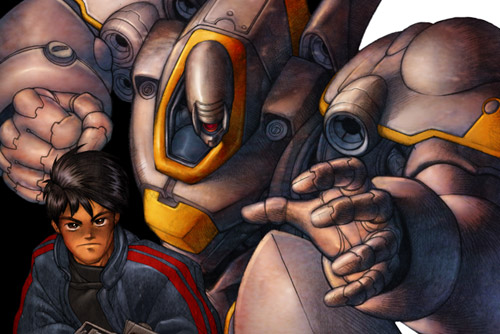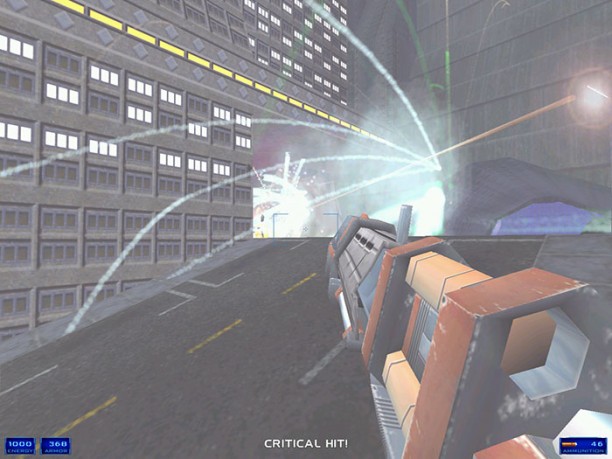
Shogo: Mobile Armor Division
Shogo: Mobile Armor Division is nothing short of ambitious. Created by Monolith Productions, utilizing their brand new Lithtech engine, Shogo combines FPS standards of the time, with the dizzying influence of Japanese anime. Featuring such elements as a critical hit system, and the ability to pilot large mecha, Monolith attempts to push the boundaries of what a first person shooter can be. However, will all of this ambition, comes a distinct lack of cohesion, and ultimately, frustration.
Good, you’re here. I’ll get to the point. Your mission is to find and eliminate Gabriel at all costs. His forces have been amassing in the abandoned city of Avernus. Within a few day we feel they will attempt a final assault on Maritropa. If Gabriel is allowed to continue, the Fallen will destroy the CMC and gain control of Chronos. If this happens the flow of Kato throughout this system will cease. This cannot, and will not be allowed to happen. I’ll see to that myself if I have to. – Admiral Akkaraju
Technology
The game itself, from a purely technological point of view, is what I could describe as nightmare. Yes, we have the debut of the ever versatile Lithtech engine (with all of its coloured lighting, shadows, 16-bit colour, etc.), but it’s delivered in a way that makes you wonder how it ever made it out of alpha testing.
The best example of the engine’s rough state would collision detection ,or, rather, the distinct lack there-of. In one harrowing retelling of the often loathed “escort the NPC” trope, you run into an elevator so you can make it to the building’s exit on the floor below. That is, you run into an elevator whose floor is seemingly made of quicksand, as your NPC ally repeatedly falls through it, only to be crushed by said descending elevator. This, of course, causes you to fail the mission at hand. Another example would be the numerous doors you pass through, which seem to do their best to catch and hold you at bay throughout the duration of the game. Perhaps though, your character has the ability to phase through objects, albeit poorly, as sometimes you tend to re-materialize within the door, which causes your immediate death.
I must also mention the game’s handling of AI, as you are presented a world filled solely with precognitives and walking vegetables. The AI within Shogo either does one of three things:
- A) They know you are coming around a corner, down a hallway, via their precognitive abilities. This results in them shooting the split second you round a corner, as their gun is already trained on you.
- B) They manage to fire through the walls, which goes back to my discussion on the lack of collision detection.
- C) They are so mentally vegetative, that they do not realize that you’ve slaughtered the five friends around them through a dizzying display of rocketry and machine gun fire. This of course leaves them staring blankly at a wall, in which case you can essentially poke them to death with your knife.
These things leave a very bad taste in your mouth, as dealing with the AI becomes a thing of frustration. The fact that the AI can see through walls also causes those who have rocket-based weaponry to routinely destroy themselves as they attempt to shoot through the wall in front of them. In fact, I spent the entirety of what I suppose was a near end-game lengthy boss battle, just standing still. You see, the boss who was placed on the top floor of a highrise building above me, began to shoot at his feet at the beginning of the battle, and continued to do so until he damaged himself enough to prompt a cut scene which shows him fleeing.
Vehicular Combat

Gameplay, of course, is the supposed big draw here. The marketing behind the game does, after all, do all it can to alert you to the fact that you are able to pilot large mecha ala Gundam Wing. The resulting gameplay however, does not really differ from standard FPS conventions.
Before I get into the mechanics of the mech conflict, as I am sure to irke those who have fond memories of this game, I assure you I realize that Monolith was striving to recreate the fast paced combat found in so many anime television series. I would just argue that they failed to do so in any effective way.
When your character climbs into his rather large MCA, as they call the mecha in the game, one would, I hope, expect a different experience from what they did whilst guiding their character on foot. You are, after all, climbing into a large humanoid robot designed for combat. When you climb into that large MCA though, the gameplay stays unfortunately the same. Being in control of an MCA is essentially just swapping your character model for something else (ohhhh look, different hands!), and providing you with a new set of MCA-centric weaponry.
I should, perhaps, elaborate on the weaponry for a moment. When you are controlling your human character, Sanjuro, you have ten distinct weapons you can use. When controlling the MCA, you are granted a set of ten different weapons to yield, bringing the grand total of weapons in the game to twenty. However, while the weapons you use as an MCA are supposed to be “cool,” they don’t feel any different than what you wield as a human. You’re still picking up guns from fallen foes, and they are all still fairly generic. I.e. A sniper rifle, a knife-like weapon, and a rifle. Yes, great, the rifle shoots lasers, but it’s really not that different than the one that shoots bullets while you’re a human. There is no tactical difference, just simply a graphics swap.
Speed is also a tremendous issue for me here. And again, yes, I realize the developers are trying to capture the mecha combat of Gundam, and similar series. However, you never really feel like you are piloting a mecha. If I moved around sluggishly, as a giant mechanical robot would, I would perhaps feel more powerful. I am, after all, a giant robot carrying around literal tons of munitions. I should be slow, yet powerful; a bipedal tank. As stated though, Monolith are trying to capture the hectic feel of Gundam, etc. The problem is, the gameplay is simply not fast enough to capture that feeling. My MCA can’t jump, run, or fire its weapons any faster than my human character can. It would really be great if I could fly, or even hover, like the mecha of so many Japanese anime shows can, but that’s not to be found here. However, the only difference from controlling your human character is, well, that a mecha has a lot of health. This doesn’t make me feel like a giant mecha, and essentially just makes the MCA levels extremely easy when compared to when you are on foot, as you now rarely die.
In the end, the MCA sections of the game are simply glorified model swaps of your characters, your weapons, and your enemies. To create the illusion of piloting a mecha, you are thrown into environments which include various buildings, all scaled down to give the desired mecha feel. However, these levels are rough compared to the on foot levels, and add little to the ensuing gameplay.
Note: I am sure someone will point out that your MCA can transform into a tank, which goes extremely fast. However, I can’t fire weapons as a “tank,” and the fact that you can transform into it instantly to retreat, without some form of penalty, is detrimental to the gameplay.
General Combat
Monolith tries its best to shoehorn in a popular Japanese gameplay convention into Shogo, to help convince you of its anime stylings. I am, of course, talking about the critical hit system so prevalent in Japanese RPGs. Your weapons in Shogo have a chance of scoring a “critical hit,” which does extra damage to your enemies, and leeches life off of them, returning it to you. This system would be all well and good, if it were not for the prevalence of said critical hits, and the fact that the enemy can also score critical hits on you.
Doing some very quick guestamations in my mind, I would have to say that a critical hit occurs in forty percents of the battles in which you participate. Which, again, wouldn’t be so bad if the “critical hit” wasn’t so comically overpowered. A pistol shot, for instance, when causing a critical hit, does near enough damage to rival a rocket (I.e. You will die). This essentially turns the combat within the game into an ongoing lottery of chance. You are wielding weapons that have an on-hit critical success chance with each shot, which really means you spend all your time wielding a machine gun. It fires the fastest of all the weaponry, so you have a better chance of scoring a hit with the stream of bullets it spews forward, in attempt to win this lottery of life and death.
This also takes a lot of strategy out of the combat. Due to the fact that the enemy could score a critical hit on you, instantly killing you in most cases, you are really left with one of two options. You can run into a room, fire as fast as you can, in a hope of hitting an enemy first. (You see, hitting an enemy also temporarily stuns them, and thus lets you continue to pepper them over and over again with bullets, until their inevitable death.) Or, when possible, you can snipe them from afar, as their accuracy at long range is akin to a drunken child throwing darts at an ant.
I should also note that the the annoyance of the critical hit prevalence ties nicely into the lack of collision detection discussed earlier. If the enemy can see, and sometimes shoot through walls, there’s a good chance you will die before you ever see them.
Odds and Ends
There are a plethora of other odds and ends that generally influenced my negative reception of the game, but are probably just me nitpicking. A lot of the guns have clips, but there are no clip indicators, so you never know when you’ll run out of bullets. Shooting and destroying the bottom crate in a stack of crates sometimes leaves the other crates floating. There is no visual indication that you are being shot (screen doesn’t flash red, etc. as is standard in most FPS games going all the way back to Wolfenstein 3D, etc.), so you sometimes don’t know you’re being shot until you’re dead (I believe there is an audio cue, but it gets lost in a stream of music and gunfire). Textures stretch, and pop in and out constantly. The character models, while cartoony in a sense that they are trying to look like anime, as extremely bad at times, especially on the main character (please see his eyes). You also have the ability to sometimes shoot during cutscenes. And, finally, you will never run out of ammo on the majority of your weapons, as enemies drop it in extremely large amounts.
Overall Impression
As you’ve probably gathered by now, I was very disappointed in the game. Yes, it’s ambitious, and yes it attempts to buck the trend of FPS game at the time, but none of this is enough. The game is far too broken in it’s delivery, never making good on its promised concepts. If you’re looking for another game of the same time period, with a compelling story and innovative ideas, look to Half Life. It was released a month later.